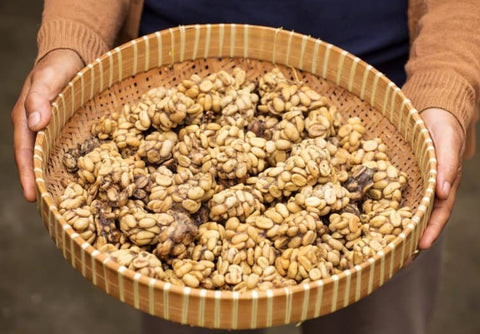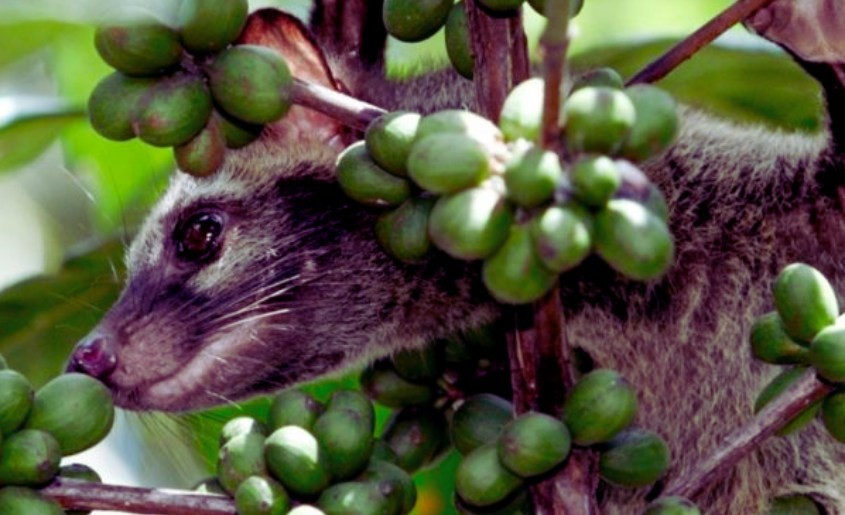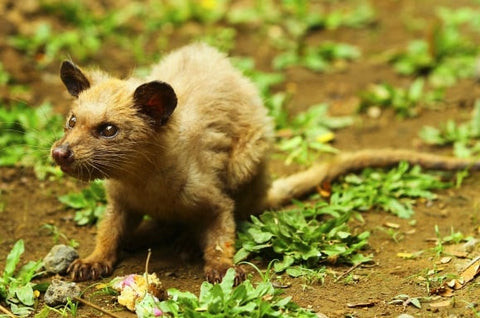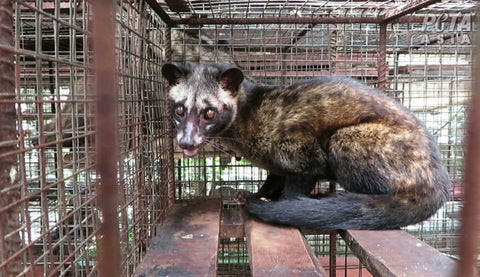The world of food and drink is undeniably fascinating. Trends emerge and fade, yet some capture our attention and endure. Kopi Luwak coffee, or “Cat Poo Coffee,” is one such trend that has intrigued the global palate.
But what exactly is kopi luwak, and why is it so special? Let’s delve into the details of this unique and often controversial coffee.
What is Kopi Luwak? The “Cat Poo Coffee” Explained
Kopi luwak is traditionally an Indonesian coffee, but its production has expanded to other Southeast Asian countries with similar environments.
In Indonesian, “kopi” means “coffee,” and “luwak” is the local name for the Asian palm civet. In the West, it’s often referred to as civet coffee, but perhaps more colloquially and directly, it’s known as cat poop coffee. It’s crucial to clarify: civets are not actually cats, despite the nickname.
The defining characteristic of kopi luwak is its unique processing method, rather than a specific type of coffee bean. While Arabica beans are frequently used, the “kopi luwak” designation hinges on the civet’s role in production.
 Asian Palm Civet Cat and Coffee Cherries
Asian Palm Civet Cat and Coffee Cherries
What Makes Cat Poo Coffee So Special? The Unique Production Process
The extraordinary appeal of kopi luwak lies in its unconventional production method.
Firstly, civets are discerning eaters, naturally selecting only the ripest and highest-quality coffee cherries. This natural selection is the first step in creating a premium coffee.
 Civet Cat Eating Coffee Cherries
Civet Cat Eating Coffee Cherries
Image Source
The magic happens during digestion. After the civet consumes the cherries, the beans pass through its digestive tract, undergoing enzymatic and chemical changes. Finally, the beans are excreted, collected, meticulously cleaned, and roasted to perfection.
It’s believed that the civet’s digestive enzymes alter the coffee bean’s composition and flavor profile, contributing to its sought-after characteristics.
The Taste of “Cat Poo Coffee”: Beyond the Novelty
Despite its unusual origin, cat poo coffee does not taste like feces. Instead, kopi luwak is celebrated for its smoothness and distinctive flavor.
One of the most noticeable traits is its lack of bitterness and lower acidity, making it gentler on the stomach compared to many conventional coffees. Some also suggest it has a lower caffeine content due to the digestive process.
 Cup of Civet Cat Poop Coffee
Cup of Civet Cat Poop Coffee
The reduced bitterness is scientifically attributed to digestive enzymes in the civet’s stomach, which break down proteins responsible for coffee’s bitter taste.
Flavor-wise, kopi luwak is often described as more nuanced and flavorful than standard coffee beans. The taste is heavily influenced by the civet’s diet and the type of coffee cherries consumed.
Expect flavor notes like:
- Earthy richness
- Subtle citrus hints
- Chocolate undertones
- Floral aromas
- Syrupy body
- A touch of jungle complexity
While subtle notes may be missed by casual drinkers, kopi luwak is generally considered easy to drink, even for those sensitive to high acidity in regular coffee.
How is Kopi Luwak Made? From Cherry to Cup
Traditionally, kopi luwak production involved foraging for droppings from wild civets. However, as demand soared, civet farming emerged.
 Indonesian Civet in its Habitat
Indonesian Civet in its Habitat
Image Source
Here’s a breakdown of the modern kopi luwak production process:
- Coffee Cultivation: Farmers cultivate coffee plants, typically Arabica.
- Civet Feeding: Ripe coffee cherries are fed to civet cats, often in controlled environments.
- Digestion: Civet digestive juices work their magic, altering the beans over 24-36 hours.
- Excretion: Civets excrete the partially digested coffee beans.
- Collection: Coffee beans are handpicked from civet droppings.
- Processing: Beans undergo rigorous washing, drying, and roasting.
- Packaging and Sale: Kopi luwak beans are packaged and distributed for sale.
The History of “Cat Poo Coffee”: From Java to the World
The story of cat poo coffee begins in the early 17th century in Indonesia, during Dutch colonial rule.
A historical depiction related to the early coffee trade in Indonesia, setting the context for the origins of kopi luwak.
Image source: AZ Animals
The Dutch established coffee plantations in Indonesia and prohibited local farmers from harvesting coffee for their own consumption. Driven by this restriction, local Javanese farmers discovered that civets consumed coffee cherries and excreted the beans undigested.
They began collecting these beans, realizing they could access coffee despite the Dutch restrictions. This “bean from droppings” was discovered to have exceptional quality and flavor, eventually gaining popularity among the upper classes and the Dutch colonizers.
However, it wasn’t until the 1990s that kopi luwak gained international recognition and became a sought-after luxury coffee.
Why is Kopi Luwak So Expensive? The Price of Exclusivity
Kopi luwak is among the most expensive coffees globally due to high demand and limited supply, coupled with the labor-intensive production process.
Limited Supply, High Demand
Annual kopi luwak production is estimated at around 50 tons, a tiny fraction compared to the 9.5 million tons of global coffee production.
Despite the small supply, the global demand for kopi luwak is substantial. The international market was valued at $6.5 billion in 2021 and is projected to reach $10 billion by 2030, highlighting its luxury status and desirability.
Labor-Intensive Production
Producing kopi luwak requires significant time and effort. Civets are selective eaters, requiring farmers to provide only the ripest cherries. The digestion process itself takes a full day.
Collecting beans from civet droppings is a laborious and arguably unpleasant task. These factors contribute significantly to the high cost of kopi luwak.
The Cost of a Cup of “Cat Poo Coffee”
A single cup of kopi luwak can range from $35 to $80. Buying beans by the pound can cost between $100 and $500.
Kopi luwak from wild civets often commands a higher price due to the increased difficulty and labor involved in sourcing compared to farmed civet coffee.
The Dark Side of “Cat Poo Coffee”: Ethical Concerns and Controversies
Despite its exotic appeal, kopi luwak production is plagued by ethical concerns, primarily regarding animal welfare.
 Caged Civets in Kopi Luwak Production
Caged Civets in Kopi Luwak Production
Image Source
The vast majority of kopi luwak comes from caged civet farms as sourcing from wild civets is inefficient and less profitable. Unfortunately, many of these farms operate under questionable animal welfare standards.
Key ethical issues include:
- Solitary Confinement: Civets are naturally solitary and territorial animals. Farms often confine them in small cages, causing stress, fighting, and disease.
- Unsanitary Conditions: Civets are sometimes kept in wire cages that can cause injuries and discomfort.
- Forced Interaction with Tourists: Civets, being nocturnal and shy, are stressed by daytime tourist visits common at some farms.
- Unnatural Diet: To maximize bean production, civets are frequently force-fed coffee cherries exclusively, leading to malnutrition and health problems, ironically impacting bean quality.
- Lack of Cherry Selection: Force-feeding prevents civets from naturally selecting the best cherries, potentially degrading coffee quality.
- Wild Population Impact: The demand for civets for farming can contribute to the decline of wild civet populations.
Due to these ethical problems, sourcing truly wild-sourced and ethical kopi luwak is extremely challenging, if not impossible to verify.
Furthermore, the market is rife with counterfeit kopi luwak. Some producers attempt to mimic the civet digestion process chemically, while others simply relabel conventional coffee as kopi luwak.
Frequently Asked Questions About Kopi Luwak
This unique coffee has sparked considerable curiosity worldwide. Here are answers to some common questions:
Is Kopi Luwak Clean and Safe to Drink?
Yes, kopi luwak is generally considered clean and safe to drink.
The processing involves rigorous cleaning. Beans are washed multiple times, the outer layers removed, and then thoroughly dried in the sun. Finally, the beans are roasted at high temperatures (around 220° Celsius), effectively eliminating any potential bacteria or germs.
While fecal contamination is a theoretical risk, the intensive cleaning and roasting processes are designed to mitigate it.
How to Prepare Kopi Luwak Coffee?
Brewing kopi luwak is similar to preparing other specialty coffees. Brewed coffee is a popular method.
Here’s a simple brewing guide:
- Preheat your coffee pot with hot water and then empty it to maintain brewing temperature.
- Grind your kopi luwak beans to a medium consistency.
- Use a 2-tablespoon coffee-to-water ratio per cup as a starting point.
- Brew using your preferred coffee machine or method.
- Savor your unique cup of kopi luwak!
Are There Other Types of “Animal Poop Coffee”? Exploring Other Unique Coffees
Yes, kopi luwak isn’t the only “animal coffee.” Here are a few other examples:
Bat Coffee
Despite the name “bat poop coffee,” this Costa Rican coffee isn’t from bat droppings. Instead, bats nibble on coffee cherries still on the branches.
Bat saliva and digestive enzymes coat the cherries, leading to a natural fermentation process. The resulting coffee is known for its delicate floral and fruity flavors with low acidity. Bat coffee is quite rare.
Bird Poop Coffee (Jacu Coffee)
This Brazilian coffee emerged in 2009. Jacu birds on Henrique Sloper’s farm selectively ate only the ripest coffee cherries.
Sloper harvested beans from bird droppings and discovered a coffee with a nutty and honeyed flavor, mild and pleasant. Jacu birds are herbivores, and their digestion is believed to enhance bean qualities.
Elephant Poop Coffee (Black Ivory Coffee)
Black Ivory Coffee, produced in Thailand, is made from coffee cherries fed to Thai elephants.
Cherries are mixed with the elephants’ regular diet. After 1-3 days of digestion, beans are collected and cleaned. Black Ivory coffee is known for its complex flavor profile: malt, chocolate, floral, cherry notes, with hints of grass, tobacco, and leather, and notably no bitterness.
Monkey Coffee
Similar to bat coffee, monkey coffee doesn’t use droppings. Rhesus monkeys in Taiwan and India chew coffee berries and spit them out.
Monkey saliva enzymes break down the beans, altering their flavor. Monkey coffee has a sugary sweet, caramelized flavor, often with chocolate, citrus, nutty, and vanilla notes. It’s relatively rare as production relies on wild monkey activity.
The Bottom Line: Is “Cat Poo Coffee” Worth It?
Kopi luwak, or cat poo coffee, remains an intriguing and luxurious coffee experience. Its unique production method and flavor profile are undeniable.
However, the ethical concerns surrounding civet farming are significant. If you consider trying kopi luwak, prioritize companies with transparent and verifiable ethical sourcing practices and authenticity certifications.
Ultimately, informed and ethical consumption is key when exploring the world of specialty coffees, including the controversial yet fascinating “cat poo coffee.”
